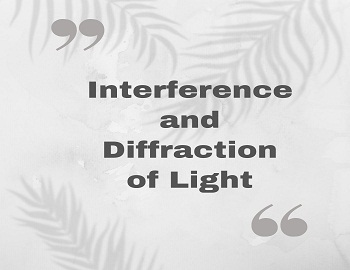Interference and Diffraction of Light:
Interference- Interference of light is the phenomenon of redistribution of light energy due to the superposition of light waves from two coherent sources. At the points, where the resultant intensity of light is maximum, Interference is said to be constructive and at points, where the resultant intensity of light is minimum, the interference is said to be destructive.
Diffraction- It is the phenomenon of bending of light around the corners of an obstacle in the path of light. Due to this, the light spreads into the regions of the geometrical shadow of the obstacle. Also, the diffraction becomes much more pronounced, when the size of the obstacle is comparable to the wavelength of light. In the case of sound waves and radio waves, diffraction is observed readily because the wavelength of these waves is large and obstacles of this size are readily available. For visible light, the diffraction phenomenon is not so common, because the wavelength of visible light is very small (≅10-6m) and obstacles of this size are hardly available. According to Fresnel, diffraction occurs due to mutual interference of secondary wavelets which are not blocked by obstacle.
Following are the points of difference between Interference and Diffraction of Light-
| Interference | Diffraction of Light |
|---|---|
| Interference is due to the superposition of two different wavetrains coming from two coherent sources. | Diffraction is due to the superposition of secondary wavelets from different parts of the same wavefront. |
| In the case of interference, all bright bands are of the same intensity. | In the case of diffraction, the bright bands are not of the same intensity. |
| The intensity of minima is generally zero, and there is a good contrast between bright and dark fringes. | The intensity of minima is never zero and hence there is poor contrast between bright and dark bands. |
| The width of interference fringes may or may not be equal. | The width of diffraction fringes is always unequal. |
| Bands are large in number. | Bands are a few in number. |
| Bands are equally spaced. | Bands are unequally spaced. |









Comments (No)